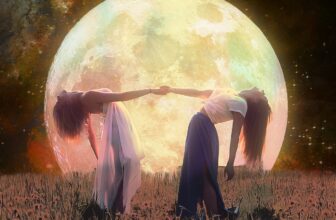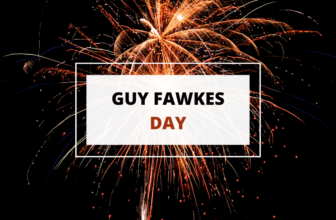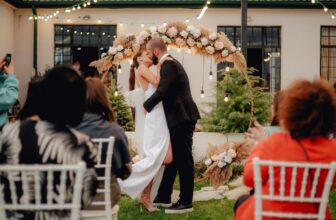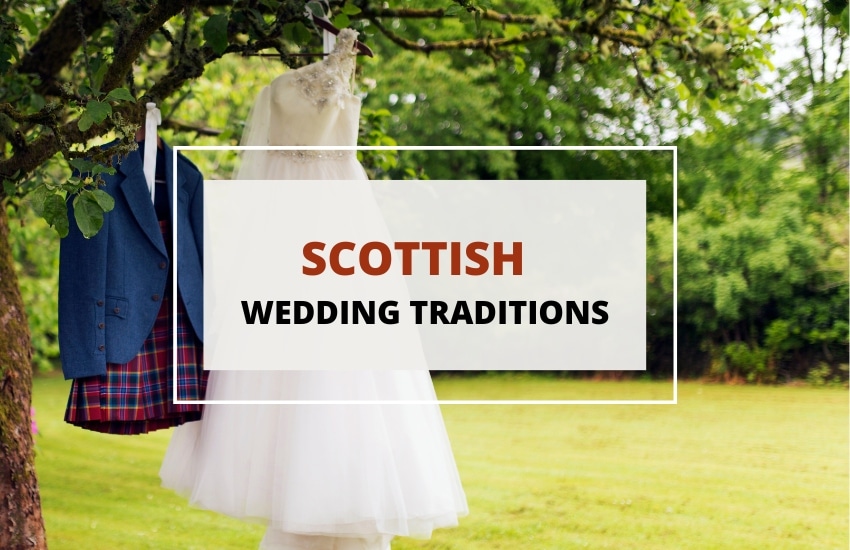
Table of Contents
Weddings are the celebration of a union between two people. Each culture has its different variations of it and the customs they tend to practice when one is being celebrated. Some couples really look forward to this ceremony and go all out with it.
Depending on the religion, the country, social classes, and ethnic groups, weddings will look a lot different from each other. Most wedding ceremonies include rituals such as the couple exchanging gifts, wedding rings, and vows, and engaging in rituals that are specific to their culture and background.
In the case of Scotland, there are a unique set of customs that they follow for their wedding ceremonies. From their folkloric music to special traditions and activities, their wedding culture is very rich and beautiful.
We’ve compiled the most popular Scottish wedding traditions for you to learn more about them. Are you ready?
The Sixpence Coin in the Bride’s Shoe
This wedding tradition, originally from the regions of Angus and Aberdeen, consists of the father putting a sixpence coin in one of his daughter’s shoes before she walks down the aisle. Apparently, the father must do this to wish the bride a marriage full of prosperity and happiness.
This is one of the many lucky charms that might be used in Scottish weddings. Another interesting lucky charm that people use in traditional Scottish weddings is a sprig of white heather in the bride’s bouquet.
Wearing Traditional Scottish Kilts
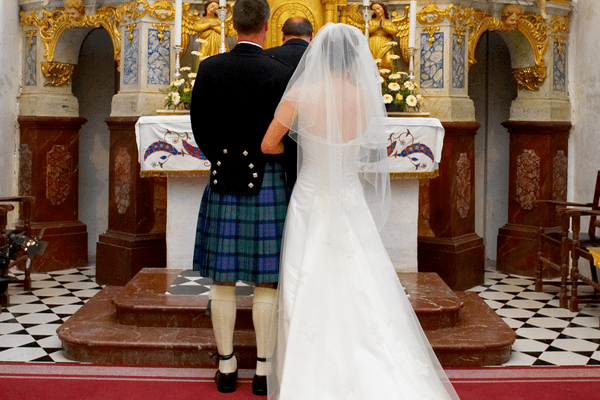
Unsurprisingly for anybody who’s aware of Scottish culture, kilts also star in traditional Scottish weddings. The groom and groomsmen will wear kilts made from the tartan of the family. The bride might also personalize her bouquet or shawl with the tartan.
The Blackening
Nowadays, people practice this tradition in rural Scotland. Its history may have to do with another Scottish wedding ritual where another married woman from the bride’s family washes her feet. But before the washing, her feet needed to be dirty first. With the passage of time, it evolved into the blackening ritual that it’s today.
This Scottish tradition was unique in that ahead of the wedding, the soon-to-be bride and groom’s friends would have the responsibility of “capturing” the couple about a week before the ceremony. The friends of the soon-to-be husband and wife would cover them in disgusting substances like oil, rotten eggs, leaves, feathers, and so on. This is said to bring luck.
However, this ritual can get a bit too rowdy, and often leaves people hurt. As Dr. Sheila Young says in this article, “If you never knew anything about blackening and you chanced upon it on a village green you would really think you were witnessing a medieval torture.”
The Luckenbooth Brooch
Wedding jewelry is sometimes as important as the dress. This traditional Scottish brooch is a small piece of jewelry that has two interlocked hearts that go beneath a crown. As a rule, the Luckenbooth has got to be silver and have precious gems encrusted in it.
Men would give this piece of jewelry when they proposed to seal the engagement. It symbolized love and their promise to be with each other forever, aside from the fact that people thought it brought luck and ward off evil spirits. This is somewhat similar to the Claddagh ring of Celtic culture.
The Bagpipes
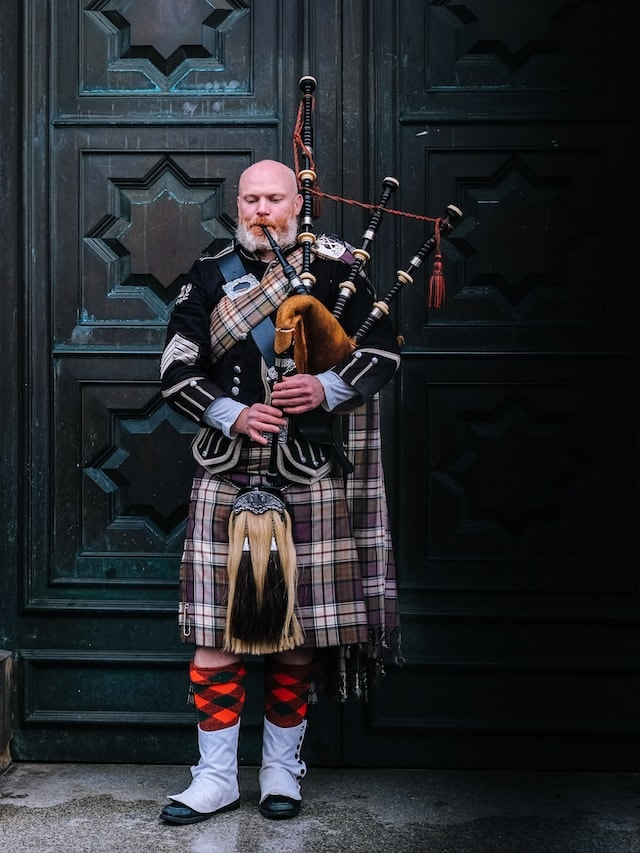
If you ever go to a Scottish wedding, you’ll probably hear the bagpipes being played during the start and the end of the ceremony. You might also see that there’s a pipe player that’ll play when the couple arrives at the wedding reception.
They’ll have a cheerful welcome, where their friends and family will sing and dance to the sound of the pipes. Additionally, after this performance ends, the piper will raise a toast in honor of the newlyweds. The sound of the bagpipes was thought to scare away any evil spirits lurking by and would bestow good luck on the couple.
Ceilidh Dancing
Ceilidh (pronounced kay-lee) is a traditional Scottish dance, which involves a lot of energetic spins and skipping steps and is done in pairs or groups. During weddings though, the most popular Ceilidh dances are the Strip the Willow, The Frying Scotsman, and the Gay Gordon’s. Usually, the live bands hired for weddings also provide someone who can teach the dances to the guests.
Gifting a Clock and a Tea Set
At Scottish weddings, a traditional gift includes a clock and a tea set. The clock is presented to the couple by the best man, while the tea set is gifted by the maid of honor. These items symbolize eternal love and happy home, perfect symbolism for a newly married couple.
The Bride’s Gift to the Groom
The bride also gifts the groom something special – a traditional shirt known as the ‘wedding sark’. This is what the groom wears for the wedding. And what does the groom do in return? He pays for his future bride’s dress.
The Quaich
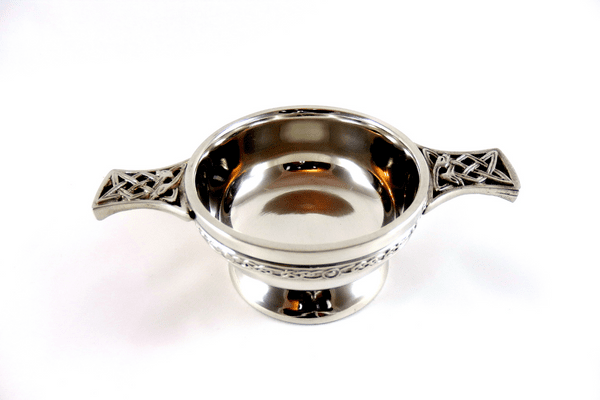
One of the most popular Scottish wedding rituals is the use of the quaich. The quaich is a cup that has two handles which the newly married couples use to raise their first toast after their wedding ceremony.
This first toast represents the trust between the both of them. It’s tradition to fill the quaich with whisky, and let the bride and groom serve a sip of the beverage to each other. They have to be careful not to let one drop spill, or it might be a bad omen for their marriage.
Bride’s Place is to The Left
In Scottish history, people saw the bride as a “warrior prize.” As a consequence, the man would only hold the bride with his left hand, so his right one would be free to use his sword to fight off anybody who might object to the union.
Tying the Knot
Have you ever wondered where the expression “tying the knot,” as a synonym for “getting married,” came from? Or… “to take each other’s hand in marriage”? If you are thinking “from Scotland,” then you’re absolutely right! These idioms come from a Scottish wedding tradition called handfasting.
Handfasting is a tradition where couples tie their hands together with a piece of cloth or with a ribbon. This symbolizes their bond, love, and loyalty to each other. The bride and groom usually after saying their vows to cement them.
Wrapping Up
As you have read in this article, these are some of the most well-known Scottish wedding traditions. Weddings are beautiful events, and they deserve to be celebrated to the fullest extent. Adding elements of culture to them always makes them extra special.




